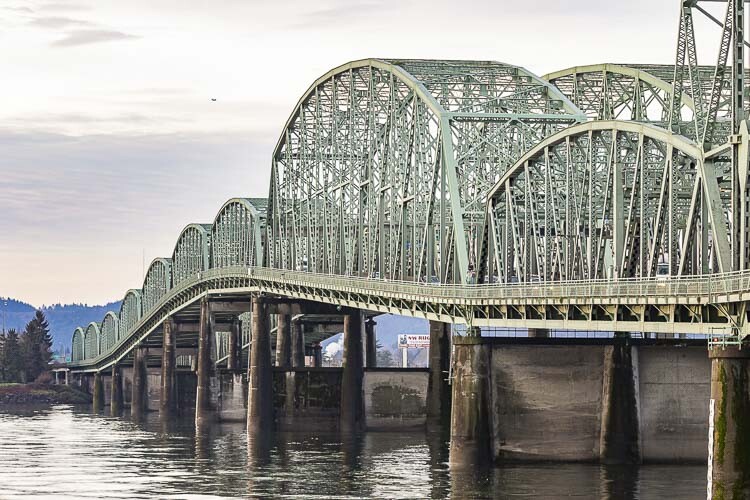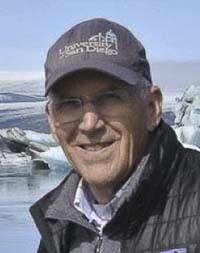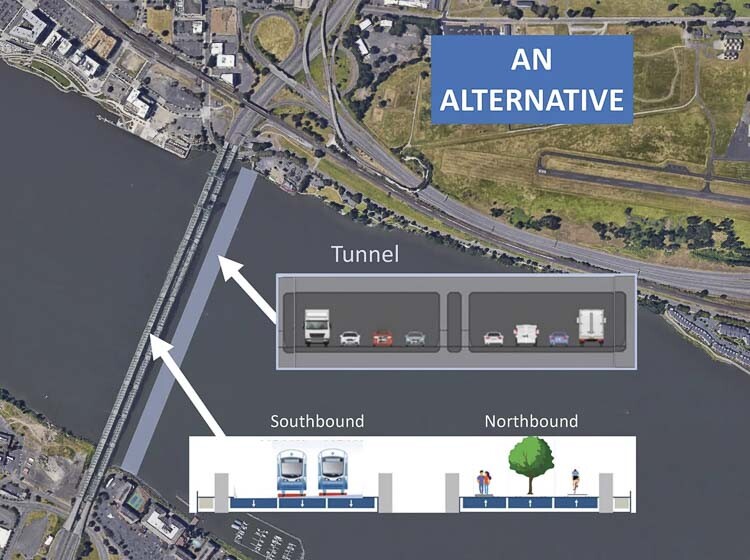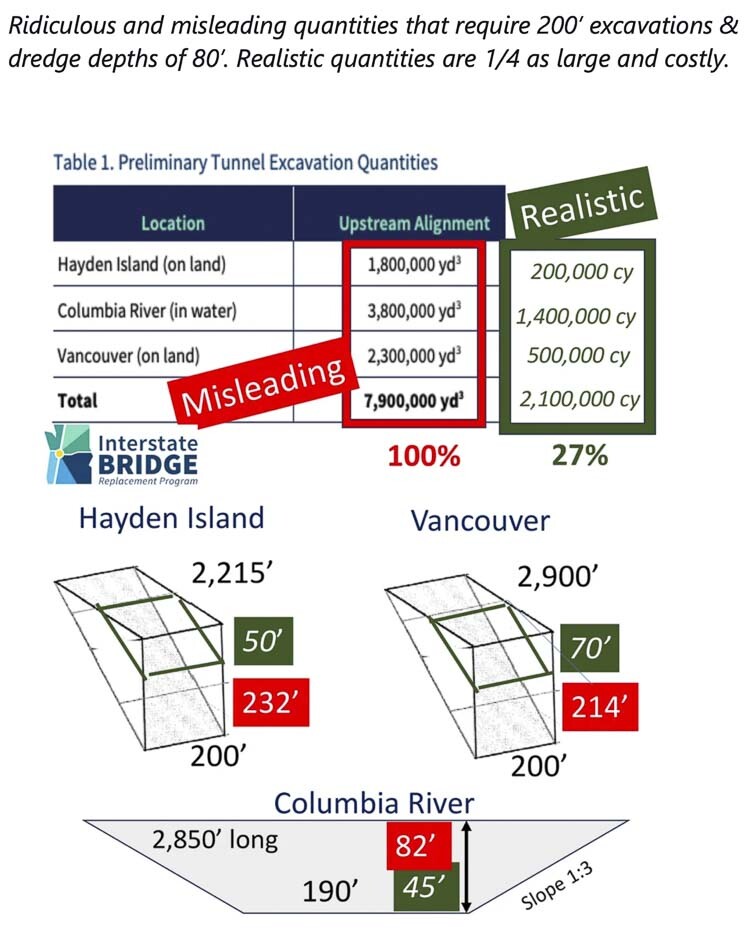
Retired Engineer Bob Ortblad believes a new study of an immersed tunnel by a consultant independent of the IBR must be done
Bob Ortblad MSCE, MBA
The Interstate Bridge Replacement Program (IBR) is the most expensive Washington highway project ever proposed, estimated to cost $5 to $7.5 billion. However, the IBR is risking $2.5 billion in essential Federal funding. IBR’s incompetence and deception will not go unnoticed by the Federal Highway Administration, U.S. Coast Guard, and U.S. Army Corps of Engineers.

Unfortunately, $300 million has been wasted promoting a dangerous bridge design to replace the Columbia River I-5 Bridge. A decade ago, the failed Columbia River Crossing (CRC) wasted $200 million and in the last three years the IBR has wasted an additional $100 million resurrecting the CRC’s failure.
The CRC/IBR bridge design is too dangerous. Two years ago, Antonio Lopez was killed by bad engineering. His SUV hit an icy curve on the I-205 Bridge and plunged into the Columbia River. The IBR’s bridge design will be steeper with a -4% downgrade, have a sharper S Curve, and an icy north-facing slope that will make it more lethal than the I-205 Bridge. Building this bridge would be more than engineering incompetence, it would be criminal.
The IBR intentionally disqualified a safer immersed tunnel alternative. A safer immersed tunnel will also reduce noise and pollution on Hayden Island, Vancouver, and Fort Vancouver. A tunnel will allow waterfront parks, can be built in half the time, and have less impact on salmon during and after construction. A tunnel will also enable the repurposing of the current southbound bridge for transit and a repurposed northbound bridge for walkers and bikers that would be a popular civil attraction.

Two years ago, on July 17, 2021, when the IBR team presented their “Tunnel Concept Assessment,” I challenged the inflated estimate of excavation and dredging. Program Administrator Greg Johnson assured me that WSP/USA consultants were experts and had done their research. Thirteen professional engineers and four consultants signed the report. With no professional engineer’s stamp, this unofficial report was used to disqualify an immersed tunnel alternative to the public and government officials. The legality of the report was challenged, and the IBR finally had the report stamped on April 19, 2023, by a professional engineer, twenty-one months after it was issued.
Last month, from a Public Disclosure Request, I obtained the IBR’s excavation and dredging calculations and drawings. My analysis confirmed my original doubts. The estimated 7.9 million cubic yards is wildly inflated. Every one of the 158 cross-section areas used to compute cubic yard volume is incorrect. A realistic estimate is 2.1 million cubic yards. This massive error of 6 million cubic yards can only be explained by intentional deception. Confronted with this error, after three weeks, the IBR pleaded incompetence. The IBR claims data was duplicated, and problems with third-party software, and quantity errors are common. The IBR just issued Revision 2 of its “Tunnel Concept Assessment” admitting its quantity estimate of 8 million cubic yards is 4 million cubic yards too large. An estimate error of over 6 million cubic yards is closer to the truth. The IBR surreptitious release of Revision 2 should be shared with local, state, and federal agencies that made decisions on this report. The IBR claims infallibility and refuses to retract this report.

Local political leaders rushing to grab Federal funds may ignore IBR’s deceit. The cities and ports of Vancouver and Portland plus C-TRAN, TriMet, Oregon Metro, and SW Washington Regional Transportation Council have all approved IBR’s bridge, the only alternative offered. The IBR has told them there is fierce competition for Federal funds. A Supplemental EIS requires evaluation of alternatives. The IBR is offering a single dangerous bridge alternative and ignores a safer immersed tunnel alternative, risking the loss of Federal funding. The Environmental Protection Agency will never approve the IBR single alternative-bridge Supplemental EIS and the IBR will lose $2.5 billion of Federal funding.
The IBR must retract this report and notify the public and government agencies that relied on it. WSP/USA must refund its consulting fee. A new study of an immersed tunnel by a consultant independent of the IBR must be done. An immersed tunnel alternative must be included in the IBR’s Supplemental EIS.
Bob Ortblad is a retired Civil Engineer, MBA, and CPA. He taught the history of infrastructure at the University of Washington, presented “Who Built Seattle” at Seattle Town Hall, and has experienced the infrastructure of seventy countries. He has lived on Capitol Hill in Seattle for 40 years.
Also read:
- Opinion: Hiding the growing cost of the Interstate Bridge replacementJoe Cortright of the City Observatory addresses the rising cost of the Interstate 5 Bridge replacement project.
- 90 minutes of delay on Southbound I-5 in Southwest Washington on Friday afternoon, July 26Travelers using southbound Interstate 5 through Woodland should expect up to 90 minutes of delay during Friday afternoon and evening and should delay travel or prepare for additional travel time.
- Nighttime paving work on I-5 and SR 14 in Clark County July 28-Aug. 9Nighttime travelers in Clark County should expect delays for maintenance and paving work beginning Sunday, July 28 until the morning of Friday, Aug. 9.
- Northeast 182nd Avenue/Northeast Ward Road to be closed on Aug. 1Northeast 182nd Avenue and Northeast 172nd Avenue in Clark County will have single-day closures on August 1 and August 5 for road preservation, with detours in place.
- Interstate Bridge Replacement program awarded $1.499 billion FHWA Bridge Investment Program grantInterstate Bridge Replacement program officials have shared that the program received $1.499 billion through the Federal Highway Administration’s Bridge Investment Program.










Why do all things that are confusing, misleading, error prone, overly expensive, probably corrupt and don’t always make sense have roots leading back to WSP 💵😬💸😬.City of Camas certainly has followed that same path 😉😉😉.
A tunnel would be much better at reusing the existing approaches, accommodating light rail stations which are easy to access and allowing for bike/walk access. Amazing that the public gets sold that a high bridge would be better.
We don’t want the crime train in Washington
No crime train – Portland wants Clark County voters to pay for their crime train – total waste of money!
yeah except when you realize that the tunnel will have to go UNDER the railroad tracks and then you have hwy 14 traffic 30 feet above the magical tunnel… then what?
I like the idea of creating an additional access across the Columbia. I think it is crazy to think they could close down and rebuild the 1-5 bridge for a year while they rebuild. I don’t like the tunnel idea for the fact that no flammable loads can access i-5 at that point. lets build a better bridge over at T-4 and then rebuild this one taller and wider
How can I help?
I have been an advocate for years of building a tunnel under the Columbia. The technology to do this is there and the disruption to current traffic flows would be minimal.
With continued growth, how do you widen the tunnel? How much does widening a tunnel cost compared to a bridge?
I like the tunnel idea but afraid it would have to be way too massive and probably impractical to accommodate a minimum of 8 lanes of vehicles (that I think is too few), MAX, and it certainly wouldn’t be friendly for pedestrian and bicycle traffic. Multi/modal transportation is necessary and requires an open air bridge.
Forward thinking Vancouver needs MAX and wants it, even though it’s very expensive! The crime train is a fallacy and is a fear tactic. Done nicely passenger problems can be minimized. I remember when the I-5 bridge was tolled, and unfortunately believe it has to be done again, fairly with discounts available to some!
Local and regional commercial and private traffic critically needs better throughput at the I-5s West Coast, regional, and local WORST choke point. The anti-freeway-ers need to understand the overall economic and environmental positive benefits of a new bridge. It’s disgusting when you see the wasted time, economic activity, and environmental damage caused by barely moving vehicles pouring CO2 into the atmosphere now!
I appreciate the seemingly simple and attractive features the tunnel engineers have offered, but I’m afraid a that a tunnel with the required capacity would need to be as wide and high as several massive box stores lined up end to end under the Columbia, that to me would be impractical if not impossible.
Look, we’ve studied this for years, the price has doubled since the last bridge attempt. All the design considerations and design parameters have been reviewed hundreds of times, and the delay tactics from some are far worse than any malfeasance, if any, by public officials.
I’d like to see this critical project at least started in my lifetime, appreciate the all-inclusive Democratic process, but as Columbia River and other fisher-folks say, it’s “high time to fish or cut bait”!
Let’s build this bridge NOW!
amen to that ^
nice to see common sense and knowledge in the comment section
You obviously have never rode MAX! I have for decades, with the soft on crime approach that the liberal clown show has implemented!The MAX in the last few years is a very dangerous place to be stuck in a moving tube with people doing drugs,defecating and other crimes!Is a danger to the public!!!
The whole idea of spending billions to replace the I5 bridge when transportation is changing rapidly is crazy. Most of the traffic is single occupancy vehicles. For a fraction of the replacement cost you could buy everyone in Clark County a small electric car, divide the lanes in half and double the capacity of the bridge. One lane for trucks , lower the speed limit and voila…..problem solved with forward thinking.
You obviously have never rode MAX! I have for decades, with the soft on crime approach that the liberal clown show has implemented!The MAX in the last few years is a very dangerous place to be stuck in a moving tube with people doing drugs,defecating and other crimes!Is a danger to the public!!!